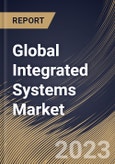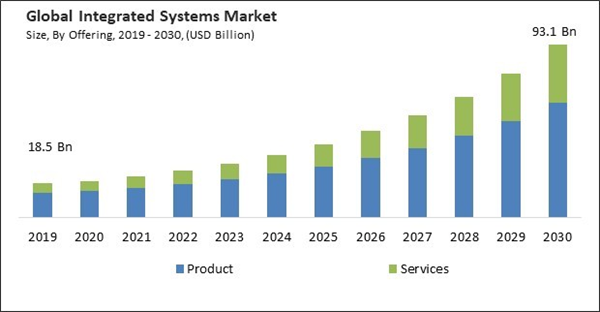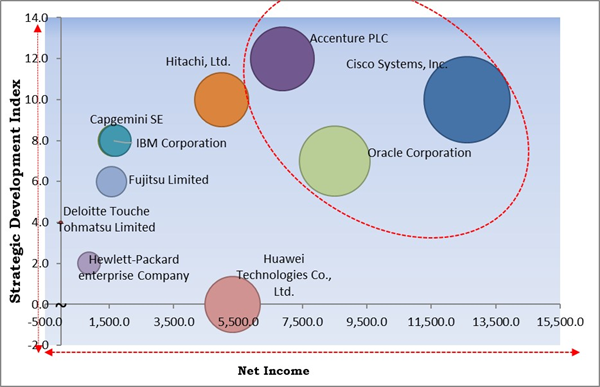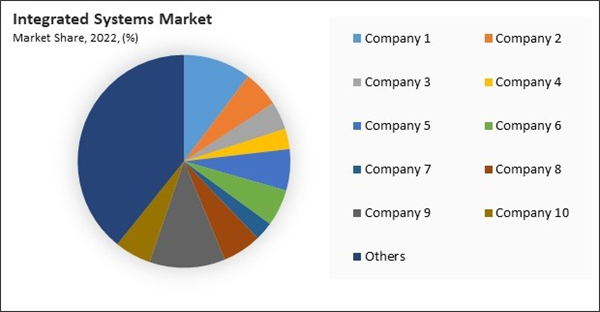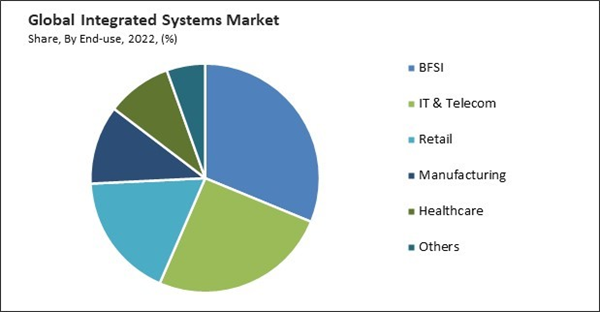The Global Integrated Systems Market size is expected to reach $93.1 billion by 2030, rising at a market growth of 17.9% CAGR during the forecast period.
The emergence of Industry 4.0 has been a pivotal driver for integrated systems in manufacturing. The Industrial Internet of Things (IIoT), automation, data analytics, and cyber-physical systems are all part of Industry 4.0, which focuses on the digital transformation of manufacturing processes. Hence, the manufacturing sector accounted for $2,829.7 million revenue in the market in 2022. Integrated systems are at the core of smart manufacturing, enabling real-time data analysis and process optimization. Integrated systems are increasingly being used to automate various manufacturing processes. Robotic automation systems, known as "cobots" (collaborative robots), are integrated into production lines, working alongside human operators to improve productivity, precision, and safety. Therefore, the demand will increase in the coming years.
The major strategies followed by the market participants are Mergers & Acquisition as the key developmental strategy to keep pace with the changing demands of end users. For instance, In August, 2023, Accenture PLC completed the acquisition of ATI Solutions Group Pty Ltd to augment its position in the fields of specialized digital and industrial talents in West Australia. Moreover, In September, 2023, Cisco Systems, Inc. came into an agreement to acquire Splunk Inc., an American software company. Through this acquisition, the companies would introduce next-generation AI-enabled security. Additionally, the companies would provide security and resilience to the companies through threat detection and prevention.
The leading players in the market are competing with diverse innovative offerings to remain competitive in the market. The above illustration shows the percentage of revenue shared by some of the leading companies in the market. The leading players of the market are adopting various strategies in order to cater demand coming from the different industries. The key developmental strategies in the market are Acquisitions.
The market research report covers the analysis of key stake holders of the market. Key companies profiled in the report include Accenture PLC, Capgemini SE, Cisco Systems, Inc., Deloitte Touche Tohmatsu Limited, Fujitsu Limited, Hitachi, Ltd., Hewlett-Packard enterprise Company, Huawei Technologies Co., Ltd., IBM Corporation, and Oracle Corporation.
The emergence of Industry 4.0 has been a pivotal driver for integrated systems in manufacturing. The Industrial Internet of Things (IIoT), automation, data analytics, and cyber-physical systems are all part of Industry 4.0, which focuses on the digital transformation of manufacturing processes. Hence, the manufacturing sector accounted for $2,829.7 million revenue in the market in 2022. Integrated systems are at the core of smart manufacturing, enabling real-time data analysis and process optimization. Integrated systems are increasingly being used to automate various manufacturing processes. Robotic automation systems, known as "cobots" (collaborative robots), are integrated into production lines, working alongside human operators to improve productivity, precision, and safety. Therefore, the demand will increase in the coming years.
The major strategies followed by the market participants are Mergers & Acquisition as the key developmental strategy to keep pace with the changing demands of end users. For instance, In August, 2023, Accenture PLC completed the acquisition of ATI Solutions Group Pty Ltd to augment its position in the fields of specialized digital and industrial talents in West Australia. Moreover, In September, 2023, Cisco Systems, Inc. came into an agreement to acquire Splunk Inc., an American software company. Through this acquisition, the companies would introduce next-generation AI-enabled security. Additionally, the companies would provide security and resilience to the companies through threat detection and prevention.
Cardinal Matrix
Market Competition Analysis
Based on the Analysis presented in the Cardinal Matrix; Accenture PLC, Cisco Systems, Inc. and Oracle Corporation are the forerunners in the Market. In October, 2023, Accenture PLC took over SIGNAL, a Japanese integrated marketing firm. Through this acquisition, Accenture supported the market transformation of the clients overpaid and owned media. Additionally, Accenture strengthened its ability to accelerate the business transformation of its clients and build a competitive base in the market. Companies such as Hitachi, Ltd., Capgemini SE, IBM Corporation are some of the key innovators in the Market.Market Growth Factors
Efficiency and cost reduction benefits for organizations
Organizations across various industries increasingly recognize the value of integrated systems in improving their operations. The desire to streamline processes and reduce complexity strongly incentivizes more companies to adopt these systems. This growth can be seen in various sectors, from IT and data centers to manufacturing, healthcare, and beyond. A growing number of adopters contributes to the market's maturity. This, in turn, attracts more attention from technology providers, which leads to further innovation and development of these systems tailored to the specific needs of different industries. With the positive impact of cost savings, more organizations are encouraged to explore the market. The barriers to entry decrease, making it easier for businesses to consider implementing these solutions, which, in turn, fuels market growth. Therefore, these factors will boost the demand for these systems in the coming years.Expanding digital transformation in various industries
The growth of digital transformation is fueled by a combination of technological advancements, evolving business paradigms, and changing consumer expectations. Rapid developments in digital technologies, such as artificial intelligence (AI), the Internet of Things (IoT), cloud computing, and data analytics, provide the foundation for digital transformation. These technologies enable organizations to automate processes, collect and analyze data, and enhance decision-making. Organizations seek to optimize their operations by streamlining processes and reducing operational costs. Automation and digital tools play a crucial role in achieving these goals, making businesses more efficient and responsive. The market will grow in the coming years due to these factors.Market Restraining Factors
Complex integration process and need for expertise
The complexity and expertise required for integration can deter many organizations, particularly smaller businesses or those with limited IT resources, from considering these systems. This reduces the overall pool of potential customers and hinders market growth. Specialized skills and expertise come at a cost. Organizations may need to hire or contract IT professionals with expertise in integration, which can lead to higher expenses. As a result, the overall cost of adopting these systems may become prohibitive for some organizations. The time and effort required for complex integrations can delay an organization's ability to realize the benefits of integrated systems, such as improved efficiency, cost savings, and innovation. This delay can be a disincentive for potential adopters. Therefore, these factors are expected to hinder the future market's growth.The leading players in the market are competing with diverse innovative offerings to remain competitive in the market. The above illustration shows the percentage of revenue shared by some of the leading companies in the market. The leading players of the market are adopting various strategies in order to cater demand coming from the different industries. The key developmental strategies in the market are Acquisitions.
Services Type Outlook
On the basis of services type, the market is divided into integration & installation, consulting, and maintenance & support. The integration and installation segment recorded the maximum revenue share in the market in 2022. As businesses seek tailored solutions to meet their needs, the demand for integration and installation services has surged. Integrators work closely with clients to design and implement systems that align with their unique requirements, from data centers to smart manufacturing solutions. Integrated systems are becoming increasingly complex, encompassing many technologies, from IoT devices to cloud-based applications. Integration and installation services are necessary to ensure these components work seamlessly together, meeting performance and reliability expectations. Therefore, the segment is expected to grow rapidly in the coming years.End-use Outlook
Based on end-use, the market is segmented into BFSI, IT & telecom, retail, manufacturing, healthcare, and others. The BFSI segment held the largest revenue share in the market in 2022. The BFSI sector has witnessed a profound digital transformation in recent years. Traditional banking processes and financial services are rapidly shifting towards digital platforms. To give clients a seamless and unified experience, this transition requires integrating numerous systems, including core banking, payment processing, and customer relationship management. To modernize fundamental banking activities, integrated systems are essential. Banks and financial institutions combine their core banking systems with other technology solutions, such as CRM, data analytics, and mobile banking, to improve customer service and streamline internal processes. These factors will propel the growth of the BFSI segment in the future.Offering Outcook
By offering, the market is divided into products and services. In 2022, the services segment garnered a significant revenue share in the market. Integrated systems often need to be customized to meet the unique requirements of different organizations. Service providers offer customization and tailoring services to ensure that these systems align with the specific needs of their clients. Integrated systems require continuous support, updates, and maintenance. Service providers offer ongoing services to ensure the integrated systems operate smoothly and securely. This provides peace of mind for organizations and allows them to focus on their core operations. These factors will help in the expansion of the services segment.Product Type Outlook
Based on product type, the market is segmented into integrated platform/workload systems and integrated infrastructure systems. The integrated platform/workload systems segment held the largest revenue share in the market in 2022. Integrated platform/workload systems combine hardware, software, and management tools into a single, pre-configured solution. This simplifies deployment, reduces complexity, and accelerates time-to-value for businesses. These systems are designed to provide optimized performance for specific workloads. They are often highly scalable, allowing organizations to easily expand their infrastructure as their needs grow, which is particularly beneficial for data-intensive workloads. These factors are expected to boost the demand in the segment.Regional Outlook
By region, the market is segmented into North America, Europe, Asia Pacific, and LAMEA. The North America segment procured the highest revenue share in the market in 2022. North America is home to many technology giants and data-intensive industries. As a result, there is a strong demand for integrated systems to streamline data center operations. Technological advancements, such as hyper-converged infrastructure and software-defined solutions, have driven growth in this segment. Organizations are constantly seeking more efficient and innovative ways to manage their data, which has led to the adoption of cutting-edge integrated systems. Owing to these factors, there will be increased demand in the segment.The market research report covers the analysis of key stake holders of the market. Key companies profiled in the report include Accenture PLC, Capgemini SE, Cisco Systems, Inc., Deloitte Touche Tohmatsu Limited, Fujitsu Limited, Hitachi, Ltd., Hewlett-Packard enterprise Company, Huawei Technologies Co., Ltd., IBM Corporation, and Oracle Corporation.
Strategies deployed in the Market
Partnerships, Collaborations, and Agreements:
- Sep-2023: Oracle Corporation formed a partnership with Mastercard Inc., the second-largest payment-processing corporation. Under this partnership, Oracle incorporated Oracle Fusion Cloud Enterprise Resource Planning (ERP) into the banks to organize the B2B payment and financing processes.
- Jun-2023: Capgemini SE has partnered with Amazon Web Services (AWS), a subsidiary of Amazon that provides on-demand cloud computing platforms. Through this partnership, lifecycle optimization for aerospace was introduced. The Lifecycle Optimization for Aerospace platform boosted the adoption of circular economy in the aviation industry through automation of the inspection process and guidance to increase their lifespan.
- Apr-2023: Accenture PLC formed a partnership with Conga, the developer of the Conga Suite for cloud-based document generation. Through this partnership, the clients were able to modify their revenue lifecycle management processes. Additionally, the companies helped several organizations around the world computerize their revenue processes to bring about growth in their businesses.
- Oct-2022: Accenture PLC came into partnership with Atlassian, Inc., an Australian software company. Through this partnership, Accenture created more technology investments and businesses consisting of enterprise agility services. Additionally, the companies supported clients at every step in incorporating their employment agility services, like product-centric development and lean management principles connecting strategy to execution.
- Jun-2022: Cisco Systems, Inc. came into partnership with Kyndryl, Inc., a company that manufactures advanced and reliable technology infrastructure. Through this partnership, the companies helped the businesses transform their operations into cloud computing services that make hybrid IT management easier.
- Jun-2022: Hitachi Energy, a subsidiary of Hitachi, Ltd., collaborated with Schneider Electric, a French multinational company specializing in digital automation. Through this collaboration, the companies provided energy transition and increased customer value. Additionally, the companies brought about faster deployment of grid solutions for their customers.
- May-2022: Oracle Corporation formed a partnership with Informatica Inc., an American software development company. Through this partnership, the data integration and governance products of Informatica were integrated with the Oracle Cloud Infrastructure (OCI). Additionally, this partnership offered cloud data management and governance solutions for enterprise analytics and databases.
- Feb-2022: Hewlett-Packard Enterprise Company collaborated with Qualcomm Technologies, Inc., a company engaged in the manufacturing of semiconductors. Through this collaboration, the next generation of 5G distributed units was introduced in association with the Qualcomm X100 5G RAN, an inline accelerator card from Qualcomm Technologies.
- Jul-2021: Capgemini SE partnered with CONA Services LLC, a platform for integration and collaboration for all the bottlers in the Coca-Cola system. Through this partnership, a new set of distribution digital solutions and consumer products were released. Additionally, the enterprises incorporated with top technology platforms were provided with insights to function competitively in the asynchronous demand-driven market.
- Apr-2021: Fujitsu Limited joined hands with Siemens Digital Industries Software, an American computer software company. Through this collaboration, the companies provided a competitive environment for their customers and introduced digital transformation (DX) in the manufacturing industry, starting with the Japanese market. Additionally, Fujitsu resold industry-specific solutions from the Xcelerator portfolio of Siemens in the Japanese market and provided solutions strengthening those abilities.
Product Launches and Product Expansions:
- Oct-2022: Oracle Corporation unveiled the Oracle Alloy, which is a cloud infrastructure platform. Oracle Alloy allows service providers and independent software vendors (ISVs) to become cloud providers and introduce cloud services for their customers. The new product offers businesses a full set of cloud services and several additional value-added services to meet specific market needs and industry requirements.
Acquisition and Mergers:
- Oct-2023: Accenture PLC took over SIGNAL, a Japanese integrated marketing firm. Through this acquisition, Accenture supported the market transformation of the clients over paid and owned media. Additionally, Accenture strengthened its ability to accelerate the business transformation of its clients and build a competitive base in the market.
- Sep-2023: Cisco Systems, Inc. came into an agreement to acquire Splunk Inc., an American software company. Through this acquisition, the companies would introduce next-generation AI-enabled security. Additionally, the companies would provide security and resilience to the companies through threat detection and prevention.
- Sep-2023: Fujitsu Limited took over Innovation Consulting Services (ICS), a SAP consultancy based in Thailand. Through this acquisition, Fujitsu enhanced its position in SAP consulting and management services in the Asia-Pacific region.
- Aug-2023: IBM Corporation completed the acquisition of Apptio Inc., a leading technology spend and value management software provider. Through this acquisition, Apptio's products were merged with the IT automation portfolio of IBM to provide businesses with a 360-degree technology management platform. This platform assisted businesses in automating and optimizing decisions in their IT landscapes.
- Aug-2023: Accenture PLC completed the acquisition of ATI Solutions Group Pty Ltd., a full-service information technology company. Through this acquisition, Accenture augmented its position in the fields of specialized digital and industrial talents in West Australia.
- Sep-2022: Hitachi, Ltd. completed the acquisition of Flexware Innovation, Inc., a leading technology integrator. Through this acquisition, Hitachi improved its position in the businesses of SCADA (Supervisory Control and Data Acquisition), ERP (Enterprise Resource Planning), Software Development, Business Intelligence (BI), and MES (Manufacturing Execution Systems) in North America.
- May-2022: Capgemini SE formed an agreement to acquire Chappuis Halder & Co., an international management consulting firm. Through this acquisition, Capgemini broadened its advising abilities towards banking and insurance clients in Europe, North America, and Southeast Asia. Additionally, the acquisition augmented the consulting services of the company in environmental and climate risk strategy.
- Feb-2022: IBM Corporation acquired Neudesic, LLC, a technology partner in business innovation. Through this acquisition, the by-product multicloud services of IBM were enhanced, and the hybrid cloud and AI strategy of the company was strengthened.
- Jul-2021: Hitachi, Ltd. took over GlobalLogic Inc., a known digital product engineering company. Through this acquisition, Hitachi's capability to promote social innovation businesses using digital technology was strengthened. Additionally, Hitachi expanded its Lumada digital solutions business to advance the digital transformation of social infrastructure.
- Jun-2021: Cisco Systems, Inc. acquired Kenna Security, Inc., a SaaS risk and vulnerability intelligence platform. Through this acquisition, the machine-learning risk-based vulnerability management platform of Kenna Security was amalgamated with the SecureX platform of Cisco to produce the largest endpoint security footprint in the market.
- Jun-2021: Deloitte Touche Tohmatsu Limited completed the acquisition of Aptys Consulting, a provider of cloud-based enterprise payments software. Through this acquisition, Deloitte established its position in the SAP market through the addition of 'SAP Ariba', a Center of Excellence.
Scope of the Study
Market Segments Covered in the Report:
By Offering- Product
- Integrated Platform/Workload Systems
- Integrated Infrastructure Systems
- Services
- Integration & Installation
- Consulting
- Maintenance & Support
- BFSI
- IT & Telecom
- Retail
- Manufacturing
- Healthcare
- Others
- North America
- US
- Canada
- Mexico
- Rest of North America- Europe
- Germany
- UK
- France
- Russia
- Spain
- Italy
- Rest of Europe- Asia Pacific
- China
- Japan
- India
- South Korea
- Singapore
- Malaysia
- Rest of Asia Pacific- LAMEA
- Brazil
- Argentina
- UAE
- Saudi Arabia
- South Africa
- Nigeria
- Rest of LAMEA
Key Market Players
List of Companies Profiled in the Report:
- Accenture PLC
- Capgemini SE
- Cisco Systems, Inc.
- Deloitte Touche Tohmatsu Limited
- Fujitsu Limited
- Hitachi, Ltd.
- Hewlett-Packard enterprise Company
- Huawei Technologies Co., Ltd.
- IBM Corporation
- Oracle Corporation
Unique Offerings
- Exhaustive coverage
- The highest number of Market tables and figures
- Subscription-based model available
- Guaranteed best price
- Assured post sales research support with 10% customization free
Table of Contents
Chapter 1. Market Scope & Methodology
Chapter 2. Market at a Glance
Chapter 3. Market Overview
Chapter 4. Competition Analysis - Global
Chapter 5. Global Integrated Systems Market by Offering
Chapter 6. Global Integrated Systems Market by End-use
Chapter 7. Global Integrated Systems Market by Region
Chapter 8. Company Profiles
Companies Mentioned
- Accenture PLC
- Capgemini SE
- Cisco Systems, Inc.
- Deloitte Touche Tohmatsu Limited
- Fujitsu Limited
- Hitachi, Ltd.
- Hewlett-Packard enterprise Company
- Huawei Technologies Co., Ltd.
- IBM Corporation
- Oracle Corporation
Methodology

LOADING...


